When lives are on the line, Helicopter Emergency Medical Services (HEMS) providers around the globe rely on Airbus rotorcraft. The following profiles represent a cross-section of these operators, listed in alphabetical order.
Operators in the fight to save lives
ADAC Luftrettung
German HEMS (Helicopter Emergency Medical Services) helicopters are named “Christoph” after St. Christophorus, the patron saint of travellers. This tradition started in 1970, when the country’s automobile club, ADAC (Allgemeiner Deutscher Automobil-Club), established the first permanent HEMS base in Munich and introduced its initial helicopter – a bright yellow Bo 105 with the aircraft registration D-HILF ("hilf" is the German word for “help!”).
Today, its ADAC Luftrettung operation is one of Europe’s largest HEMS organisations, evolving in response to the booming introduction of automobiles in Germany beginning in the 1960s – with the number of traffic accidents rising dramatically.
In 1967 alone, there were some 20,000 traffic-related deaths, and experts determined that 15-20% of those fatally injured would have had a chance of survival if emergency care had been faster. Time was lost – among other causes – due to the incomplete stationing of rescue vehicles and the high density of traffic on the roads, which made it difficult for helpers to get on the spot quickly.
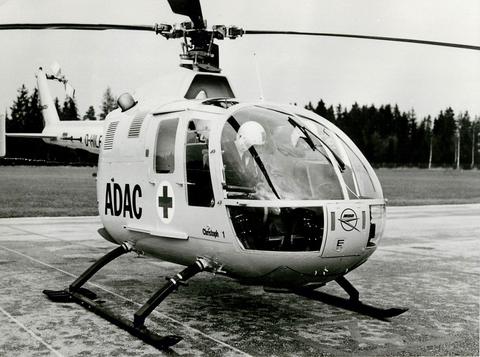
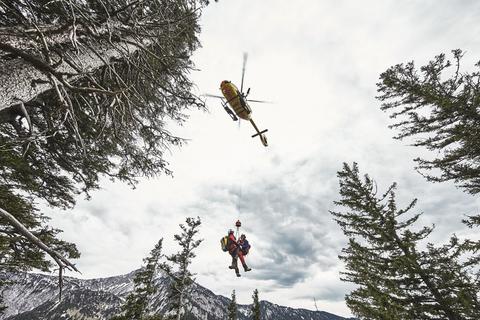
Today, there are more than 80 air rescue locations from various operators in Germany. The crews of ADAC Air Rescue are on duty every day at 37 stations, with more than 50 Airbus-built rescue helicopters of the H145, H135 and EC135 versions. Nationwide, almost 1,300 people work for the non-profit ADAC Luftrettung, which has been a subsidiary of the ADAC Foundation since 2017 – including some 160 pilots, approximately 250 emergency paramedics, 150 technicians and 600 emergency doctors
Since the start in 1970, the "flying yellow angels" (as ADAC’s rescuers are known in Germany), have flown over one million missions. Every year they are called on more than 50,000 rescue deployments.
The ADAC rescue helicopters are generally ready for action from 7 a.m. to sundown. After receiving an alarm, they are usually airborne within two minutes to bring the emergency doctor and services to the patient.
Air Jet Táxi Aéreo
Air Jet Táxi Aéreo is a Brazilian company providing safe, agile, accessible, and versatile executive air transport, including aeromedical and specialised air services. Since 2012 under the direction of the Prevent Senior Group, Air Jet is in strict compliance with all safety standards established by the National Civil Aviation Agency (ANAC).
Created in 1997, Prevent Senior was born with the objective of being specialists in welcoming and caring for the elderly. They have about 9,000 professionals (as of December 2020), distributed among administrative areas and their own network composed of advanced medicine centres, specialised centres, diagnostic medicine facilities and the Sancta Maggiore hospital network.
Since Prevent Senior is a health-oriented company and fully committed to the constant evolution of its processes and services, there was a significant desire to provide cutting-edge care even in areas outside the scope of the health plan. This goal became a reality with the purchase of Air Jet in 2012.
Whether transporting professionals or patients, helicopters bring tranquillity, safety, and agility to provide excellent service. Therefore, Air Jet has made available the latest equipment and a team of doctors and nurses specialised in inter-hospital air and land transportation.
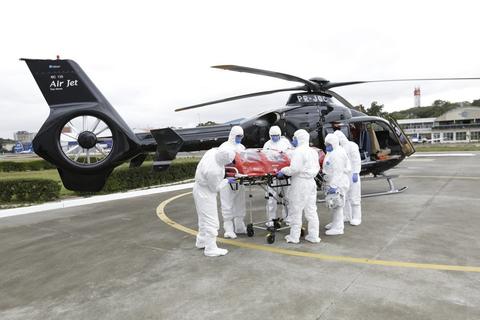
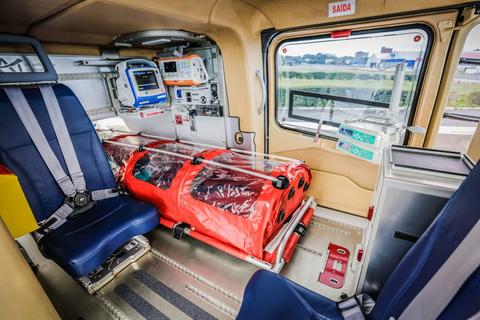
Air Jet's helicopter fleet includes two Airbus H125s, an Airbus Dauphin and an Airbus EC135. Air Jet expects two brand-new Airbus H145 to be delivered in 2021, completing its fleet.
Air Jet strictly complies with the rules of ANAC, and after flights, all aircraft are sanitised according to safety protocols. Aircraft maintenance also is carried out in state-of-the-art workshops properly approved by ANAC.
The removal of patients through specialised teams and equipped aircraft also have become standard amid COVID-19. During the pandemic, Air Jet carried out specific training so that the entire crew could guarantee the safety and agility in the aerial removals of patients. The company also obtained isolation capsules (PID) for transporting critical patients.
The airlines that provided this service had an exponential increase in hours flown. Air Jet’s total hours flown grew by 660% – 253 in 2020 compared to 33 in 2019. The trips included both private aircraft charter and assistance to Prevent Senior beneficiaries, who have access to the service at no additional cost in emergency cases.
Over the course of 2020, 85 patients were removed from distant locations from São Paulo – the most distant, Boa Vista, in Roraima (4,681 kilometres from São Paulo). Of these 85 patients, 17 were victims of COVID-19 and were transported in aircraft equipped with aerial intensive care units (ICUs), equipped with isolation mechanisms, and staffed by health professionals specialised in the activity.
Aiut Alpin Dolomites
When mountain climbing gained popularity in northeastern Italy’s Dolomites during the 1950s, the number of accidents also increased significantly. Born from the spirit of solidarity and the motivation of numerous volunteer mountaineers from the region, the association Aiut Alpin Dolomites was founded in 1990. Today, it comprises 17 mountain rescue teams that have saved more than 17,000 people (as of 2020).
While rescue operations previously were carried out by mountain guides with simple climbing equipment, the rescue teams today use modern hardware adapted to the requirements of the region – including steep rock faces – and they are backed by the availability of an H135 emergency rescue helicopter.
In 2020 alone, the association records show that more than 900 people were rescued. Of this total, 30 were recovered by the helicopter in hovering operations – without the possibility of landing at the site. Each mission took an average of 34.8 flight minutes, and the helicopter was used on 58 night flights. In addition to saving lives, the rescue service also enhances the attractiveness of tourism, which is the region’s main source of income.
Until 2003, the missions were carried out with single-engine helicopters. With the adaptation to European Union directives in 2003, a changeover was made to the twin-engine helicopter in Airbus’ H135 rotorcraft family.
Since March 2015, the latest H135 version has been in service. This helicopter is equipped with a 90-metre-long cable winch with a pulling force of 272 kg., a double-load hook, medical equipment for resuscitation and stabilization of the patient, as well as snow skids.

Babcock France and SAMU 06

In the Alpes-Maritimes region of southern France, the yellow helicopter of France’s emergency medical service, SAMU 06, is known as a guardian angel. Attached to the Centre Hospitalier Universitaire de Nice (CHU) and based at Hospital Pasteur 2, SAMU 06 is part of a network of 105 SAMUs (the French acronym for: Urgent Medical Aid Service) that began in the 1960s to provide emergency medical services in France, with helicopter operations taking shape in the 1980s.
Onboard the SAMU 06 helicopter is an emergency medical team, alongside the specialised flight crew of operator Babcock France.
Together, this expert team achieves 400+ helicopter missions per year in a region known for its diverse geography and meteorological extremes. The 4,300 square kilometre area extends from the low Southern Alps to the Mediterranean coast and the island of Corsica. Flight crews frequently encounter complex flying conditions such as storms, snow, maritime overflight conditions, along with southern France’s infamous mistral winds.
Across France, Babcock operates a fleet of 32 Airbus-built helicopters (25 H135s and seven H145s) dispatched at 28 SAMU bases. Together, they completed more than 15,500 missions in 2019.
Unlike other French SAMUs, a majority of the missions performed by SAMU 06 are primary missions – or in-field rescues and transports, 15% of which are conducted at altitudes greater than 15,000 feet. As an example, a SAMU rescue to the skiing resort Isola 2000 that takes more than 1 hr. 50 min. by ground ambulance is reduced to only 20 minutes using a helicopter.
One year ago, SAMU 06 began operating a new H145, greatly appreciated for its performance, high availability, spacious and flexible cabin, and state-of-the-art equipment. “With the H145, we feel we can tackle almost any mission,” explained Dr. Christophe Lemesle, responsible for HEMS (Helicopter Emergency Medical Services) dispatch at Nice Hospital. “Additionally, we now have the cabin space to carry a second patient or an accompanying family member. We also can take more equipment on board, enabling us to manage back-to-back missions with a much wider range of patient cases.”
The H145 enables SAMU 06 to go beyond its standard mission perimeter. A recent example was the SAMU 06 lending a hand to neighbouring SAMU 83 for a mission requiring a specialised “counter-pulse” balloon for a cardiac patient. And when the village of Tende was hit with devastating flooding in early October 2020 and road access was fully cut off, SAMU 06’s H145 transported patients and material in and out of Tende and its local hospital over a 10-day period.
According to Chief Pilot Jean-Bernard Pétroni, the H145’s “must-have” features for HEMS operations in enhancing flight safety include the synthetic vision system coupled with HTAWS (helicopter terrain awareness and warning system) for situational awareness, along with a rear camera on the tail boom for mountain landings as well as the Traffic Advisory System (TAS) when flying in airspace with many airplanes. Pétroni added: “This aircraft feels like the safest platform I have ever flown.”
For Christophe Mauron, the Director of Babcock EMS France, the H145 and H135 answer the availability criteria – which is important for HEMS. “As an operator, we commit to an availability rate and therefore need a helicopter with a solid and clean design” he explained. “And if a part fails, we count on Airbus for good part availability to quickly return the aircraft to service. The overall reliability of the H135 and H145 is one of the key reasons for Babcock to choose an Airbus fleet solution.”
Bangkok Helicopter Services Co., Ltd.
While the HEMS (Helicopter Emergency Medical Services) business model is still in its infancy in Thailand, Bangkok Helicopter Services (BHS) has been a pioneer in this sector and is making inroads to build more awareness of these lifesaving operations.
Established in 2005, BHS adheres to CAMTS (Commission on Accreditation of Medical Transport Systems) standards and has quickly developed its capabilities and fleet. BHS operated two rotorcraft – an EC145 and H145 – from its base in Bangkok as of December 2020.
The company’s HEMS numbers have been particularly impressive in recent years, accumulating nearly 1,500 flight hours on 365-plus medical-related missions. BHS helicopters are flown across the country, undertaking missions in various provinces of Thailand.
BHS’ high utilisation of its rotorcraft was evident in 2014 in response to severe flooding that left many local villages in peril. Over the course of one month, BHS flew 150 flight hours with a single helicopter to rescue villagers that were either trapped or in need of medical attention. The helicopter also transferred patients to nearby hospitals and flew donation supplies to villages.
In addition, BHS has been able to transport patients requiring the use of extracorporeal membrane oxygenation (ECMO) in life support.
For the company, the heart of HEMS lies in its ability to quickly transport a patient from the accident scene to the nearest hospital or clinic to receive care and treatment.

DRF Luftrettung
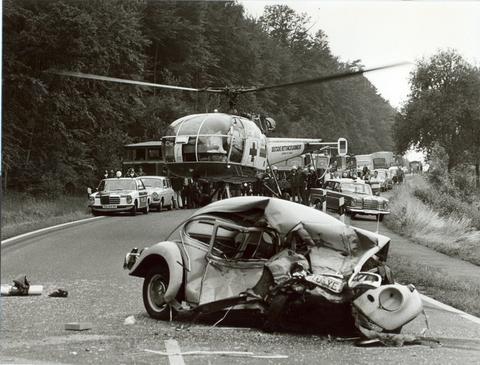
At the beginning of the 1970s, more than 20,000 people annually died from traffic accidents in Germany, as the necessary medical help often came too late.
DRF Luftrettung traces its roots to this operator’s founding in 1972 with the aim of saving lives, and has continuously evolved – including a constant renewal of the helicopter fleet. Today, DRF Luftrettung’s primary rotorcraft types are the H145 and H135 from Airbus Helicopters.
Together with its three subsidiaries, DRF Luftrettung currently operates from 35 HEMS (Helicopter Emergency Medical Services) bases in Germany, Austria, and Liechtenstein. The DRF Group carries out more than 40,000 missions annually. The DRF Group carries out more than 40,000 missions annually. Its highly professional crews and modern helicopters are on stand-by every day to react quickly to emergency rescue missions and meet the urgent transportation needs of intensive care patients between clinics.
While also flying two fixed-wing ambulance aircraft and utilising a large hangar for aircraft maintenance at its Operations Centre, the DRF Group runs its own academy as well. The Austrian ARA Flugrettung – with two HEMS bases – was integrated into the DRF Group in 2001, while the Northern HeliCopter GmbH (NHC) – which provides air and water rescue services – was acquired in 2019. Furthermore, the DRF Group is involved in the AP³ Luftrettung network at a HEMS base in Balzers/Liechtenstein.
In 2009, DRF Luftrettung was the first German air rescue organization to start operations with night vision goggles. The DRF Group currently has the most experience in nighttime air rescue missions throughout Europe, with the highest number of hours flown. At 14 of its 35 HEMS bases, DRF Group crews are on standby 24/7, benefitting from the capabilities of night vision goggles.
The DRF Group has significant expertise in hoist operations, as well. Helicopters with rescue winches are used at seven HEMS bases. In Austria, these rotorcraft can provide rapid assistance for emergencies in the high-altitude regions of the Alps. In the North Sea and Baltic Sea areas, winch-equipped helicopters are regularly deployed in water rescue missions.
“Just as in the area of night flight with night vision goggles and air rescue missions with hoist operations, DRF Luftrettung uses its experience and know-how in all core areas of air rescue in order to continuously optimize patient care, operational tactics and the safety of all those involved,” stated, Dr. Peter Huber, the COO of DRF Luftrettung.
This is the strategy behind the continued development of DRF Luftrettung’s technical capabilities at its Operations Centre, located at Karlsruhe/Baden-Baden International Airport. Today, the facility has 15 maintenance docks for helicopters and ambulance aircraft, while approximately 140 dedicated engineers ensure the airworthiness of the fleets 365 days a year. The DRF Luftrettung Sales Department offers a complete range of services to private or commercial customers, and to other aviation operators.
Airbus Helicopters and DRF Luftrettung are long-standing partners. DRF Luftrettung has been a dedicated Airbus operator, using a range of its light twin-engine rotorcraft: the BK 177, EC135, H135 and EC145. In 2014, DRF Luftrettung was the launch customer for the new H145 helicopter equipped with Airbus’ signature Fenestron shrouded tail rotor.
As of 2021, DRF Luftrettung will modify its H145 helicopters from the four-blade main rotor configuration to the five-blade arrangement, which provides additional performance. DRF Luftrettung’s technical Service Center also will offer this retrofit to external customers.

Hiratagakuen
Established in 1993, Japan’s Hiratagakuen serves the Kansai region. Its first Airbus rotorcraft was the H135, which was delivered in 2010.
The company operates an all-Airbus fleet, comprising 13 H135s and two H145s as of December 2020, dispatched to 10 hospitals across nine prefectures, with 75 pilots and other crew. Hiratagakuen’s first H145 entered service in mid-2018 for aeromedical operations at the Nagasaki Medical Centre.
With Japan’s full-scale deployment of air ambulances beginning in 2001, HEMS (Helicopter Emergency Medical Services) rotocraft, – known as ”Doctor Helicopters” in the country – have taken on more prominent roles, enabling rapid evacuation of casualties from affected sites, and providing critical care without delay aboard medically-equipped helicopters, while in transit to the medical facility. Nine years later, the Kansai government implemented a region-wide EMS support network and Hiratagakuen became its main operator for these life-saving missions.
“We have been well-supported by a strong Airbus fleet for nearly two decades,” said Mitsuhiro Hirata, Vice President, Aviation Operation Division of Hiratagakuen. “As we operate in a time-sensitive environment where every second matters, it is important for us to be equipped with the right helicopters for these demanding aeromedical missions.
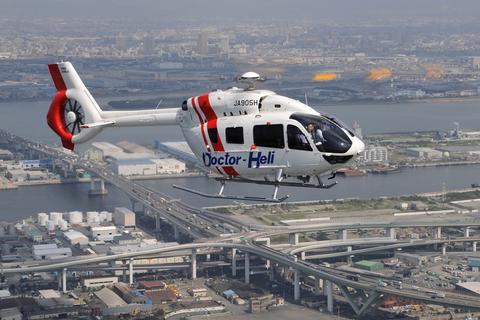

Like every company, Hiratagakuen has had its fair share of challenges over the years, such as securing yearly financial support from the Japanese government – especially when operating costs are on the rise. Other operational issues include the lack of developed hangars to house the helicopters and conducting landings on challenging surfaces such as sandy areas without watering supply, although the situation has since improved.
Hiratagakuen has undertaken numerous missions in the region. Between April 2019 and March 2020 alone, it launched 6,336 missions across its 10 bases, accumulating nearly 3,000 flight hours in total.
The company notes the 2016 Kumamoto earthquakes as one of its most significant missions, which saw Hiratagakuen dispatching several helicopters concurrently to affected areas for rescue operations.
An area that the company is most proud of is building up its capabilities to extend a wide area of coverage for HEMS operations in Hyogo prefecture, with mutual cooperation from authorities in the Kansai region.
To Hiratagakuen, HEMS is more than just a business. The company sees its operations as opportunities to play an active role in contributing to society.
HEMS in Italy
Italy was a HEMS (Helicopter Emergency Medical Services) pioneer when the first groups of rescuers in the mountains began to collaborate with flight departments of the Italian Army and Air Force in the 1960s, developing unique skills over time. Considering Italy’s particular topography (the Alps in the north, Apennines in the centre and islands to the south), it soon became essential to organise a helicopter-based service.
As with the rest of Europe, the Italian HEMS capability evolved in the 1980s through a cooperation of the medical authorities and the providers – who were the first to recognise the usefulness of air ambulance operations. It experienced a pioneering era in which the commitment, dedication and passion of doctors, nurses, mountain rescue technicians, pilots and flight technicians contributed to the current organisational and operational model. HEMS activity experienced an important increase beginning in the mid-1990s, which paralleled the progressive increase in the number and activities of the territorial emergency services.
Today, the helicopter rescue services in Italy are organised and managed by the National Health Service on a regional basis (20 regions).
Health missions are overseen by the Helicopter Management Unit of the “112” Emergency Operations Centres, with the support of the Regional Alpine Rescue for interventions in difficult mountain areas. The “112” represents Italy’s primary emergency telephone number.
At many HEMS bases, helicopter operations include the onboard presence of an alpine rescuer. A winch often is used, as there is an overlap between HEMS and SAR (search and rescue) missions.
The service providers are specialised civil operators with a COA (Air Operator Certificate) and license, issued by the Italian ENAC aviation authority – which controls the operators by applying specific European provisions for safety, organisation and maintenance.
A medical helicopter brings the specialised health team (resuscitator, “112” emergency nurse, mountain rescue technician, pilot and flight technician) to the accident site. They are capable of providing assistance both at the incident scene and in-flight during transport to the appropriate hospital. It is a team effort, where the sum of operational procedures and dedicated training enables the health and technical team to operate to high safety and medical standards.
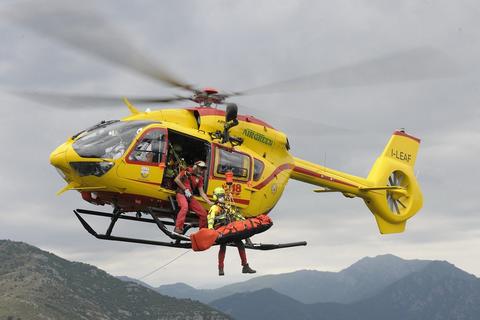

Helicopter emergency operations were extended to night-time hours with the implementation of European Union Regulation No. 965/2012 in October 2014. Such services have developed considerably with use of night vision goggles for pilots.
Almost all regions are covered by HEMS service, with a total fleet of 55 medium-weight twin-engine helicopters. In Italy’s challenging hot-and-high operational conditions, performance is a must – and Airbus is proud to supply 40% of the helicopters. The H145 version, with 22 rotorcraft in service across Italy (as of late 2020), is one of the most used helicopters, with further improvements through Airbus’ introduction of the configuration with a five-blade main rotor.
Among the Italian HEMS operators is Airgreen, which was established in 1986 and has performed HEMS activities on an ongoing basis. Since 1995, it has been in charge of the helicopter rescue service for the Aosta Valley Region, followed by the Piemonte Region from 2003, and the Sardinia Region since 2015. Airgreen has carried out multiple interventions at night, and has health teams dedicated to the transport of human organs.
Babcock MCS Italia is one of the leading operators for HEMS, along with airborne firefighting services and oil/gas missions. It has proven experience and operational capability in carrying out logistically-complex and time-sensitive missions. The company operates at 48 bases throughout Italy, from which 15,600 emergency medical services missions were performed in 2019 for a total of 16,900 patients transported.
Aiut Alpin Dolomites has operated since 1987 for mountain rescue in the Dolomites, and became a not-for-profit association in 1990. Through a partnership with another Italian operator – Star Work Sky, a high-quality service specialised in mountain rescue and ambulance by helicopter – was developed. Services using Airbus-built helicopters began with the single-engine Ecureuil, followed in 2003 by the twin-engine EC135 T2. In 2015, it was the launch customer for the EC135 T3, with this version carrying a 272-kg.-capacity external winch with 90 metres of cable.
Another HEMS provider is Elifriulia. Founded in 1971, it is the longest-running helicopter operator in Italy.
Lotnicze Pogotowie Ratunkowe (Polish Medical Air Rescue)
The first lifesaving flights were performed in Poland after World War I, using aircraft belonging to the military and aeroclubs. In 1955, the Ministry of Health and Social Security created a civilian medical aviation unit as part of the healthcare system. Soon there were 15 Medical Aviation Teams established, along with the Central Medical Aviation Team. They transported sick and injured people, medicines, blood, vaccines, and medical equipment. Medics also were taken aboard so they could carry out complicated medical operations in remote parts of the country.
In 2000, the Ministry of Health created the current HEMS (Helicopter Emergency Medical Service). Central Medical Aviation Team was dissolved, and the Polish Medical Air Rescue was established in its place. Now it is a uniform structure, financed by the Ministry of Health – which is a unique situation in the world.
After joining the European Union in 2004, Poland began preparing for an intensive modernisation of its infrastructure, including roads and railways. Consequently, the HEMS aircraft fleet was modernised, as helicopters are best suited to assist victims of road accidents. This is why in 2008 the Polish Medical Air Rescue ordered 23 new H135/EC135 helicopters, along with a flight simulator.
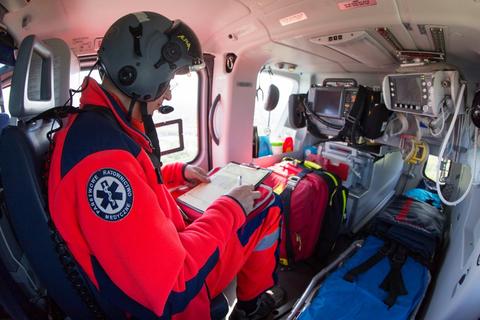
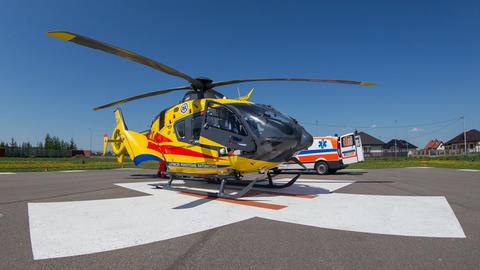
The first of these aircraft arrived in Poland in September 2009, and two months later, it began service from Krakow – kicking off a technical revolution in the Polish Medical Air Service. In 2015, thanks to EU funding, LPR purchased four additional H135s from Airbus so it could establish four new bases in the country. Expanding the number of rotorcraft led to an increase in the availability of rescue helicopters, as well as a reduction in time needed to reach patients.
Today, LPR maintains 22 HEMS bases nationwide (21 permanent and one seasonal), operating a total of 27 H135/EC135 rotorcraft. This service also includes the Airplane Transport Team, stationed in Warsaw. Its crews fly two Piaggio P.180 Avantis, with two new Bombardier Learjet 75s to be received in 2021. Each base employs pilots, doctors, nurses, and paramedics. Some 750 people work for the Polish Medical Air Rescue, including 120 pilots, 100 paramedics and 140 doctors.
The intensive modernisation of Polish HEMS resulted in high standards for medical emergency, with the number of emergency flights rising dramatically. The helicopter teams currently perform over 12,000 missions per year, 88% of which are HEMS flights, primarily responding to accidents. Each team can begin treating patients from arrival and quickly transport them to the nearest hospital within the so-called “golden hour.” The modern H135/EC135 helicopter is able to reach an accident site 60 kilometres away, depending on the wind, within several minutes.
In 2020, LPR crews flew a total of 11,000 missions, 10,650 of which utilised helicopters.
Mont Blanc Helicopters
Marc Blanc had been fascinated by rotorcraft for much of his life. In 1980, he decided to follow this passion and created a company in his local Haute-Savoie region of France. He named it “Mont Blanc Helicopters” in honour of the Alps’ highest mountain.
At first, the company mainly provided transportation services to and from ski stations in the alpine region. During the 1990s, as this activity gained traction, Blanc began providing helicopter services for aerial work, firefighting, and medevac missions – rescuing stranded or injured skiers from the inhospitable mountainous region. Helicopters were still a novelty and Mont Blanc was one of only a handful of operators to pioneer services in the region.
By the turn of the century, France’s emergency medical services (SAMU) began setting up systemised air ambulance services. With its long experience and history in pioneering rotorcraft services, Mont Blanc Helicopters was a natural fit to become one of the first operators providing HEMS services in the country.

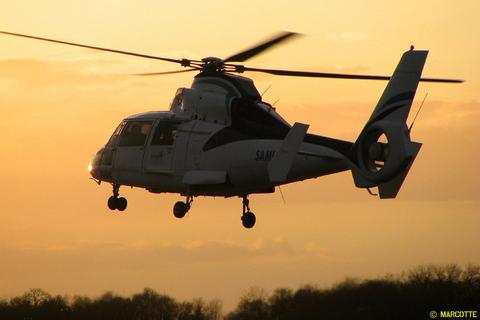
The subsidiary of Mont Blanc Helicopters, MBH SAMU, was founded in 2002 and operates out of nine SAMU bases throughout France – flying over 4,000 flight hours per year in emergency situations. It was the largest HEMS operator in France as of December 2020 – with Marc Blanc’s son, Renaud Blanc, at the helm of the company, making it the only family-run operator in France.
Ensuring its fleet of H135s, H145s and AS365 N3+ is available is paramount to Mont Blanc Helicopters’ activity; 60% of the SAMU bases operate 24 hours a day and all of them operate seven days a week. With the stakes this high, the company needed a way to guarantee their helicopters would be available when called on. They were one of the first customers to sign up for Airbus Parts by the Hour (PBH) – a primary component of the Airbus HCare Smart service offer – and today their entire fleet is covered under PBH contracts.
Norwegian Air Ambulance
A long history connects Airbus with HEMS (Helicopter Emergency Medical Services) provider Norwegian Air Ambulance, as this Norway-based company’s operations began in the late 1970s with a Bo 105 rotorcraft. More recently, the Norwegian Air Ambulance Foundation became the launch customer for Airbus Helicopters’ H145 with the five-blade main rotor configuration, which provides improved performance.
Establishing an emergency medical service system in a country like Norway is a challenge. It has the world’s longest coastline; and while Norway’s eastern part is more densely populated, the country’s western and northern regions have longer distances between populated areas – as well as poor infrastructure in certain areas. With such conditions, helicopters are perfectly suited for emergency services duties.
The first base for Norwegian Air Ambulance was established in 1978 at Lørenskog near Oslo, utilising a rented Bo 105 from MBB – an Airbus Helicopters predecessor company. There are 13 HEMS bases nationwide today, using Airbus-built H135 and H145 rotorcraft, among others.
Norwegian Air Ambulance operates three bases in the north of the polar circle: Evenes, Tromsø and Kirkenes, close to the Russian boarder. In the wintertime, these bases experience continuous darkness, as well as snow, fog and icing conditions.
The company’s service is 24/7, using night vision goggles for the entire crew. The helicopters perform deployments in the mountains, and the Dombås base regularly flies missions to Galdhøpiggen – Norway’s highest mountain – using an H135. Norwegian Air Ambulance also carries out rescue missions on glaciers, rivers, lakes and in inaccessible terrain.
It has 15 Airbus-built helicopters, and several on order for deliveries (as of 2020). Norwegian Air Ambulance’s 12 bases carried out 9,700 missions in 2019, accounting for 8,879 flight hours. The company employs approximately 60 pilots and 60 HEMS crewmembers.
The foundation will use its first H145 with the five-blade main rotor in research activities to further improve the air ambulance services. According to Eric Normann, the Director of Flight Operations Development, the foundation is planning to carry out “a large variety of medical research projects, from testing small devices that could help the service with its daily work, to more ambitious projects like putting a CT scanner on a helicopter.”
Private donators have fully funded new H145’s acquisition, a fact Norwegian Air Ambulance is very proud of.

ÖAMTC Air Rescue
In alpine regions of the world, mountain rescue is the most challenging operation for helicopters. ÖAMTC Air Rescue was established in 1983 to provide the Austrian people – as well as the country’s visitors – with emergency medical aid on any terrain.
ÖAMTC Air Rescue’s creation responded to a growing number of automobile accidents, as well as the challenges of mountain rescue. It also kicked off Austria’s rapid development of a nationwide system of emergency doctors – on ground as well as in the air. Today, the country has one of the world’s most modern HEMS (Helicopter Emergency Medical Services) systems.
Their fleet is composed of 28 helicopters (as of December 2020). All of them are Airbus-produced EC135s and H135s, which are operated at 17 emergency rescue helicopter bases during the summer season and four additional bases during the winter season. With good weather conditions, each emergency site in Austria can be reached within 15 minutes.
Every crew consists of a pilot, a doctor, and a paramedic – who in alpine regions also must be a trained mountain rescuer. Crews must undergo annual special air rescue training – and in alpine regions, a mountain rescue training programme – which evaluate overall skills and physical condition, as well as their team spirit.
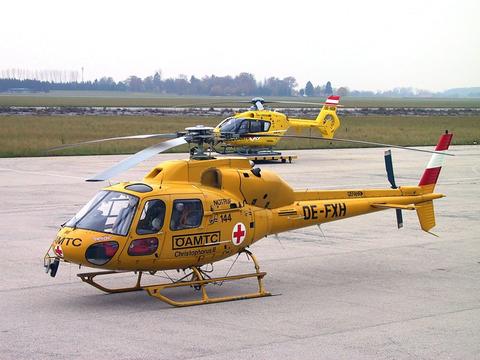
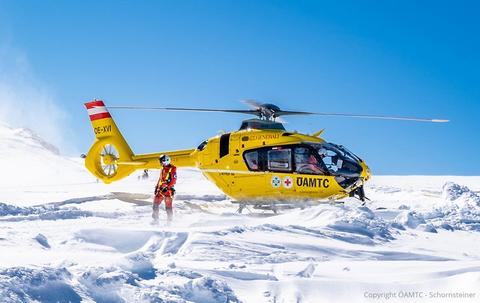
ÖAMTC Air Rescue’s helicopters are in service from dawn until the end of evening twilight – seven days a week; while two bases are operated around the clock. “Christophorus 2,” which is based in Krems/Gneixendorf, has been the only emergency medical helicopter in Austria flying in 24-hour operation.
On average, ÖAMTC Air Rescue flies some 52 missions a day. In 2019, almost half of the approximately 18,000 operations were internal and neurological emergencies. A total of 16% were caused by accidents at work, during leisure time or in the domestic environment; followed by leisure time accidents in the Alpine area.
Each rotorcraft has the most modern medical equipment. Since 2019, an ultrasound has been part of the helicopter equipment to detect life-threatening injuries such as internal bleeding in the chest and abdomen.
ÖAMTC Air Rescue has been a partner of Airbus for over 20 years. "The reliability, the high performance and good usability in the alpine environment, as well as the very good support, are factors that make the cooperation particularly interesting,” said Reinhard Kraxner, managing director of ÖAMTC Air Rescue.
SAF Group
In early January 2019, it was avalanche season in the French Alps. Near a small village, a family was trekking through the powdery snow. In the next moment, a deafening rumble was heard as a cloud of snow tumbled down the mountain, separating one of the young boys from his family. Immediately, emergency numbers were called as the family desperately sought help to retrieve their son.
In less than 10 minutes time, an Airbus Helicopters-built H135 operated by the SAF Group peeked over the horizon and flew straight towards the accident site, an area completely covered in snow, accessible only by helicopter. On board were the SAF pilots and rescue team, some of the world’s most experienced professionals in high-altitude rescue and air medical operations. The boy was quickly retrieved, treated on board and in less than one hour, reunited with his family.
Such stories as these were deemed impossible in the same region only half a century earlier. But with HEMS (Helicopter Emergency Medical Services) provider SAF Group – which was founded by Roland Fraissinet in 1979 – these rescues have become commonplace.
Roland Fraissinet, who had flown war planes as part of the Free French Forces in World War II, was inspired by the advanced mountain rescue operations of neighbouring Switzerland, and aimed to introduce similar capabilities for the French Alps.


SAF Group’s air operations initially were built around the SA315 Lama helicopter, and later with the Alouette III. As the organisation evolved, an agreement was struck between SAF Group, France’s Securité Civile government agency and the French Gendarmerie – which proved to be the beginning of a long and unique para-public collaboration that is still working today.
The SAF Group continued to evolve, and in 2006, it acquired Paris-based HEMS operator Helicap – which also had roots dating back to the 1970s. Combining the HEMS expertise of Helicap with the mountain rescue experience of SAF created a truly formidable team when it came to saving lives in difficult circumstances. As SAF’s CEO Tristan Serretta put it: “Rescuing is in our DNA.”
Today, SAF Group is one of the leaders in HEMS operations, with 15 hospital bases throughout France and its overseas territories. With two full flight simulators, it is dedicated to continuously improving the skills and expertise of its crews.
SAF Group’s current fleet comprises 60 Airbus-built helicopters operating seven days a week for all types of civilian rescue and protection operations, 25 of which are from the H135 family and are dedicated to HEMS and mountain rescue missions. The start of operations of the new five-bladed H145 is planned for this summer 2021 in Belgium.
Overall, SAF Group has transported more than 5,500 patients, carried out over 1,000 mountain rescues and conducted some 7,000 emergency medical service missions last year.
STARS
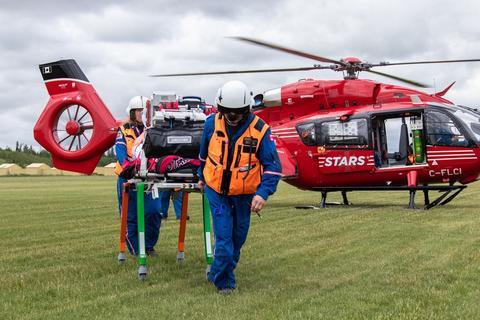
Canada’s STARS air ambulance service was founded by two physicians – Dr. Greg Powell and Dr. Rob Abernathy – whose personal experience showed them the advantages that aerial transport brought in saving patients’ lives.
With a fleet of 14 helicopters, the company now serves communities in three provinces in western Canada.
“We take the job seriously. The accountability, we think, is massive,” says Andrea Robertson, STARS President and CEO. “We want to make sure that we’re putting the very best hands on our patients, so our operations are really like taking a flying intensive care unit to them.”
“Canada is characterised by vast geographic areas and small populations which might not have access to a hospital, particularly those providing higher-level care,” Robertson continued. “The people of Canada see helicopter EMS as a means of having rapid access to critical care wherever they are.”
STARS can cover such distances effectively, deploying the 11 helicopters in its fleet.
In 2014, the company began looking for an aircraft capable of serving their six bases; they subsequently chose the H145, for a total of nine to be delivered by 2022. “The decision was made to go to a single platform because of safety and economics, particularly in crews’ training needs,” said Robertson.
The company’s missions take them from the Hudson Bay in the north to the Rocky Mountains in the west. “It’s not uncommon for some of our flight profiles to be up to 100 naut. mi. one way – a radius of action in which the H145 shines because of its increased speed,” says STARS pilot John Carson. Based in Calgary, Carson’s work takes him and his co-pilot – plus the medical crew of a nurse and flight paramedic – into the Rockies and beyond.
“Operating on the eastern slopes of the Canadian Rockies, which are prone to warm Chinook winds, can be quite challenging. And operating into them at night is an added challenge,” said Carson. “The H145 cockpit is fabulous on night vision goggles, with fantastic visibility. The 4-axis autopilot serves to decrease pilot workload in certain situations. Increasing situational awareness and safety are the HTAWS (helicopter terrain awareness system) as well as the synthetic vision system. These fantastic pieces of kit shine when we go into our mountain environment.”
“One of the H145’s attributes that we hope not to see is the aircraft’s ability to hold a single-engine service ceiling,” said Carson. “From Calgary, it’s not uncommon for our en route legs to be as high as 10,000 feet. If we lose an engine and the conditions are of an appropriate nature, we can go right over the top in the H145.”
To carry out its work saving lives, STARS has contracts with three provincial governments, under which the company handles medical oversight and is accountable for getting patients to the appropriate level of care. They operate their own dispatch centre, and staff a 24-hour emergency consultation centre. And training is done in-house, too, with experienced pilots like John Carson handling the flight crew’s transition to the new H145s. Paramedics and nurses undergo a different, though equally intensive continuing education programme.
“It’s awe inspiring when you see the professionalism of our team and how seriously they take safety,” added Robertson. “Bringing on a new aircraft is a lot of work. We feel so fortunate to have this great aircraft and it takes a strong group of professionals to do it well and do it safely.

Swiss Air-Rescue Rega
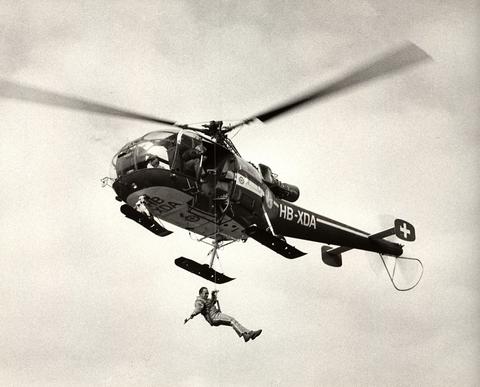
Swiss Air-Rescue Rega is one of the world’s oldest air rescue organisations, responding to accidents in the Swiss Alps where sites are difficult to reach from the ground. Rega has achieved many milestones in the course of its history and continues to set standards in mountain rescue today.
In December 1952, a Swiss pilot carried out Swiss Air-Rescue’s first helicopter rescue at Davos, Switzerland. Rega's initial permanent helicopter base was established in Zurich during 1968. In 1971, the air rescue operation received its first helicopter financed exclusively from donations: an Alouette III SE 316, built by one of Airbus Helicopters’ predecessor companies. This rotorcraft type formed the backbone of the Rega helicopter fleet for many years.
One of the most spectacular Rega rescue operations took place over Yverdon airfield in September 1980: a skydiver’s parachute became entangled in the tail wheel of the jumper’s aircraft. The air rescue helicopter’s crew managed the almost impossible feat of freeing the parachutist while in flight.
Rega is a not-for-profit private foundation and is financed by donations. With over 3.5 million patrons, it is firmly rooted within the Swiss population. The helicopter fleet includes seven Airbus Helicopters H145s stationed at the lowland bases. In addition, Rega operates an Airbus-built H125 for training purposes. Rega also deploys three ambulance jets, flown worldwide for seriously ill or injured patients.
In addition to Rega’s previous operation of the legacy Alouette III rotorcraft from an Airbus Helicopters predecessor company, it also utilised the first twin-engine ambulance helicopter, the Bo 105.
In 2019, Rega flew a total of 16,782 missions, of which 12,257 were performed with helicopters. Approximately 400 employees – including some 80 helicopter- and jet-rated pilots, along with 110 medical staff – play a decisive role in fulfilling Rega’s goals.
Ernst Kohler, CEO and Chairman of the Management Board, summed up the operator’s overall mission: “With all of the technical progress to date, Rega’s goal still remains the same. We put people at the centre of everything we do and deliver medical assistance by air to wherever it is needed.”
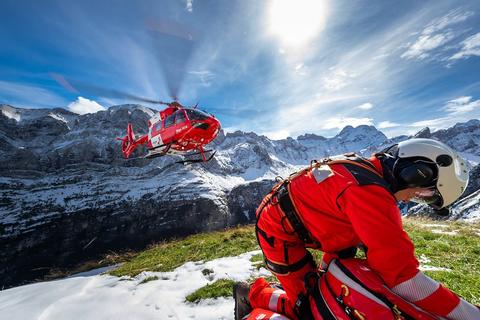
HEMS in the UK
In the United Kingdom, HEMS (Helicopter Emergency Medical Services) has evolved during three decades, and its development followed an unusual path based almost entirely on charitable funding. The combination of a lack of central government finance, fierce community pride, and cold financial reality resulted in a unique network of what today is 21 charitable trusts supporting the operation of 39 helicopters throughout England, Scotland, Wales and Northern Ireland.
The services’ genesis was in Cornwall – the remote south-western peninsula of England – where a rural road network, widespread tourism, and a lengthy coastline with rugged terrain make the provision of robust ambulance coverage something that is highly desirable to secure while challenging to achieve.
Acknowledged as the brainchild of former Royal Navy helicopter pilot Geoff Newman, the First Air Ambulance Service Trust (known today as Cornwall Air Ambulance) launched in April 1987. Flying an Airbus legacy Bo 105 rotorcraft provided at reduced rates by Bond Helicopters, it had the encouragement of the Cornwall ambulance service. The first patient was a rock climber with spinal injuries recovered from Porthcurno at the far end of the Cornish peninsula.
Initial funding from the local health authority subsequently was withdrawn, and a new charity – the Cornwall Air Ambulance Trust – successfully took over. Newman went on to be a leading figure in the air ambulance movement, and the Cornish success rapidly spawned a succession of comparable operations.
London followed in 1989, where Newman eventually became chief pilot. By 2000, there were 15 regional services in action. More recently, Air Ambulance Northern Ireland launched, with the stand-up occurring in 2017.

Only in Scotland – with its mountainous terrain, far-flung islands and widely dispersed population – is the funding/operating model different. The Scottish Air Ambulance Service is a government-financed arm of the ambulance service operating Airbus-built H145s. Even in this scenario, the provision is supplemented by Scotland’s Charity Air Ambulance (SCAA) with two H135s.
Today, air ambulance operations are an integral part of the UK’s “999” service, equivalent to 911 or 112 emergency response elsewhere in the world, and its medical staffs are largely seconded from the National Health Service’s (NHS) regional trusts. Such operations are typically tasked by the NHS, and the role is to deliver a critical-care team to incident scenes, provide care on-site, fly patients to the most appropriate hospitals, and deliver them to the hospital personnel.
The charities’ autonomy has enabled them to experiment rapidly with clinical innovations, such as roadside REBOA (Resuscitative endovascular balloon occlusion of the aorta), a technique for dealing with trauma to the aorta; and ECMO (extracorporeal membrane oxygenation), a method for dealing with serious illness related to the heart and lungs.
Airbus is proud to supply approximately two-thirds of the UK air ambulance helicopter fleet, including 14 H135s, 11 H145s and two AS365s (status as of late 2020).
Across the country, the HEMS network performs more than 70 missions per day, of which about 32% are medical emergencies – most commonly cardiac-related; and 68% are traumatic injuries, still the most common cause of death among people under 40 years of age in England. At an average cost of £2,500 each, the 25,000 missions annually require more than £60 million in funding, virtually all of which is provided by charitable donations.
An umbrella campaigning body – Air Ambulances UK – represents the charities as a lobbyist and undertakes national fundraising campaigns, which the individual charities can capitalise upon. It persuaded the government to eliminate VAT (value-added tax) on air ambulance fuel, and has repeatedly secured ad hoc grants from the administration: most recently a £6 million cash injection was made as the COVID-19 pandemic reduced charitable giving.
An important continuing issue for UK HEMS is the provision of, and consistent access to, helicopter landing sites. Another charity, set up by the County Air Ambulance Trust in the English midlands in 2009 and called the HELP appeal, has achieved great success in funding new sites at hospitals and major trauma centres. Some 40 helipads have been financed by the charity, including a night-capable site in 2020 at Hull Royal Infirmary, with another 40 projects in the pipeline.
Wuhan Yaxin Hospital
In July 2019, an Airbus-built H135 helicopter landed smoothly on the helipad of Wuhan Yaxin Hospital in Wuhan, China. Onboard the rotorcraft was an 80-year-old patient with a severe acute myocardial infarction. The patient had been transported to the hospital for emergency treatment from Shangcheng County, Henan province, 180 kilometres away, in just one hour – a journey that would have taken at least four hours via ground ambulance.
The H135 was Wuhan Yaxin Hospital’s first helicopter acquisition, making the hospital among the first in China able to perform medical missions by air, and pioneering an “air-to-ground expressway for life” in this city of 11 million located in central China.
A little over one year later, the hospital had already successfully carried out around 40 HEMS missions. Its H135 had flown some 17,000 kilometres on routes covering Henan, Hunan, Jiangxi, Anhui and other provinces in China.
Among the transferred patients, the oldest was 83 years old and the youngest was just eight days old. And with the outbreak of COVID-19, the hospital set a new internal record of seven missions per week, and two missions in one day, under extremely restricted inter-regional air traffic conditions.
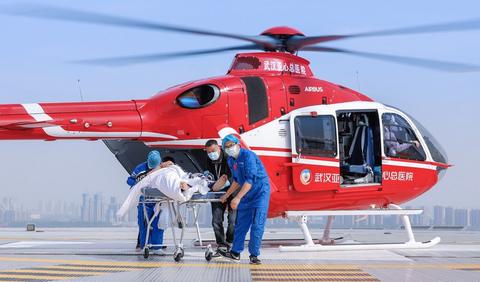

Compared to Europe and the U.S., Chinese HEMS is still in the early stages of development and is working to form an effective, sustainable business model. In addition, factors such as low-altitude airspace restrictions and the small number of standard helipads have limited the development of HEMS in China to a certain extent.
Facing such challenges, Wuhan Yaxin Hospital worked closely with general aviation companies, partner hospitals, local civil aviation authorities, airspace management and other departments to form a unique operating model where regular citizens can dial a hotline to request helicopter rescue services.
Under this model, medical crews ensure the patient’s medical safety during an air transfer, while the flight crew is responsible for flight safety. Two groups of personnel are on standby 24 hours a day, ready to take off at a moment’s notice.
Other initiatives include the formation of an air rescue alliance with more than 40 surrounding hospitals, with the goal of creating better treatment conditions while gaining valuable time. But in a country where individuals must pay their own air rescue transport, the high cost is a barrier to many. To tackle this, the hospital supports the creation of appropriate payment processes that would make HEMS more broadly accessible.
“For example, government support, insurance participation, charity assistance, and collaboration with other companies and parties could jointly support the development of China's aviation medical service," said Su Xi, president of Wuhan Yaxin General Hospital. “We are committed to building a service that is affordable to the average person, enabling our HEMS rescue platform to truly fly for everyone.”
